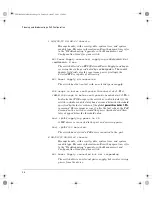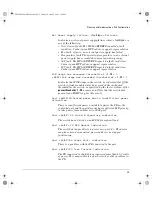
!!PWRxFish-Final01.book Page 5 Tuesday, October 7, 2003 1:58 PM
General PoE Operation
N o t e �
15.4 watts of available power is required for the switch to begin delivering
power to a port, such as when a newly connected PD is detected or when
power is released from higher priority ports. Depending on power demands,
lower-priority ports on a switch with high PoE power demand may occasion
aly lose power due to the demands of higher-priority ports. (Refer to “Power
Priority” on page 5.)
Table 1.
Port-Group Maximum Power Allocations
PoE Power
Sources
PoE for
Switch 2626-PWR
PoE for
Switch 2650-PWR
Internal
406 watts available to support PoE 406 watts available to support PoE
Only
operation on ports 1-24.
1
operation on ports 1-48.
1
Internal
Redundant 368/184
2
watts
and EPS
available to ports 1-24. (The switch
uses EPS power on ports 1-24
only
if the internal power supply fails.)
• Ports 1-24: 406 watts available (provided
by the internal power supply).
• Ports 25-48:
– 368 watts available if the EPS
connects to only one switch.
– 184 watts available if the EPS
connects to two switches.
(If the internal power supply fails, the EPS
provides either 368 watts or 184 watts to
ports 1-48, depending on whether the EPS
connects to one or two switches. Note that
38 watts of this power are always allocated
exclusively to ports 25-48.)
1
The switch uses 38 watts for internal PoE processes, which leaves 368 watts to provision
PDs connected to ports 1 - 24 (2626-PWR) or 1 - 48 (2650-PWR).
2
If both EPS ports on the HP 600 RPS/EPS are connected to switches, each switch can receive
184 watts of PoE power. If only one switch is connected to the EPS port, that switch can
receive 368 watts of PoE power.
Power Priority
When Does the Switch Prioritize Power Allocations?
If the switch can
provide power for all existing PD demands, it does not use its power priority
settings to allocate power. However, if the PD power demand oversubscribes
the available power, then the switch prioritizes the power allocation to the
ports that present a PD power demand. This causes the switch to remove
power from one or more lower-priority ports to meet the power demand on
other, higher-priority ports. (This operation occurs, regardless of the order in
which PDs connect to the switch’s PoE-configured ports.)
5








































